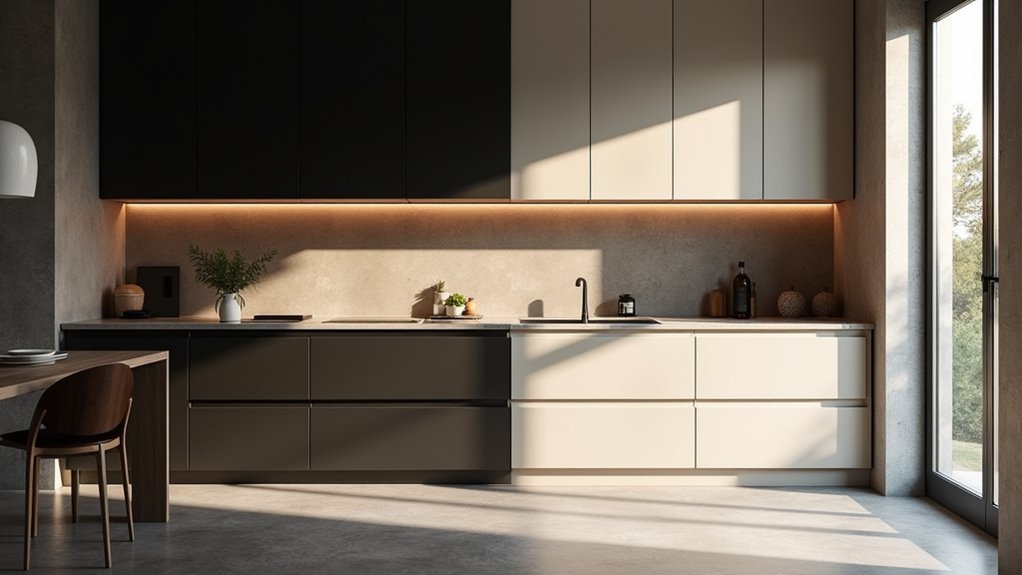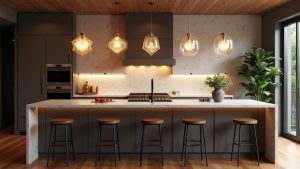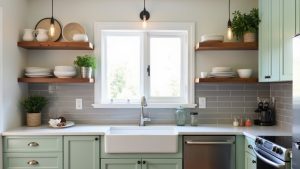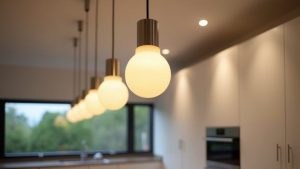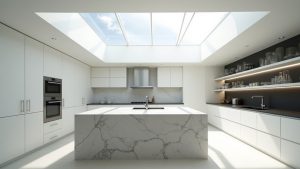Dark and light kitchen cabinets create distinct vibes and practical outcomes. Light cabinets enhance spaciousness, reflect light, and offer a timeless, welcoming feel, ideal for smaller spaces. Dark cabinets deliver bold drama and sophistication, often paired with metallic accents for a trendy edge. Maintenance differs—light shows stains, dark reveals dust. Resale value favors light tones for broader appeal. Durability varies with finishes. Styling options, lighting needs, and size perception also contrast. Explore further for deeper insights.
Key Takeaways
- Light cabinets enhance spaciousness by reflecting light, while dark cabinets create a confined look.
- Light cabinets uplift mood with brightness; dark cabinets offer bold, dramatic ambiance.
- Dark cabinets show dust easily; light cabinets reveal stains, both needing regular cleaning.
- Light cabinets boost resale value; dark cabinets may appeal to fewer buyers.
- Light cabinets pair well with dark flooring; dark cabinets contrast with light backsplashes.
Visual Impact on Space
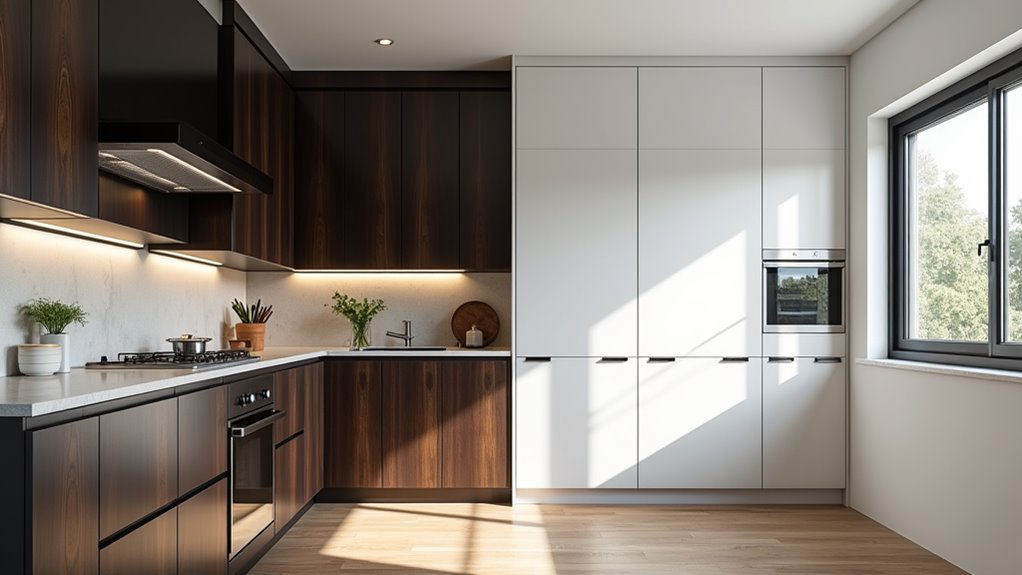
Perception plays a pivotal role in kitchen design, and the choice between dark and light cabinets significantly influences how a space feels.
Light-colored cabinets, especially white, reflect natural and artificial light, promoting spatial expansion and making even compact kitchens appear larger and more inviting. Glossy finishes on these cabinets amplify this effect, enhancing brightness and openness for clients seeking airy designs.
Conversely, dark cabinets absorb light, often creating a heavier, more confined look unless balanced with ample natural light or lighter elements. Strategic color contrast, such as pairing dark cabinets with light countertops or flooring, can mitigate this, adding depth while maintaining visual balance. Additionally, the reflective quality of light cabinets reduces lighting needs, making them energy-efficient choices for modern kitchens.
For smaller spaces, designers often recommend light cabinetry to maximize perceived room size, while larger kitchens can embrace dark tones for sophistication without overwhelming the area. This approach aligns with evolving design trends that prioritize both aesthetics and functionality in kitchen spaces. Tailoring these choices to a kitchen’s dimensions ensures a harmonious, client-focused result.
Influence on Mood and Ambiance
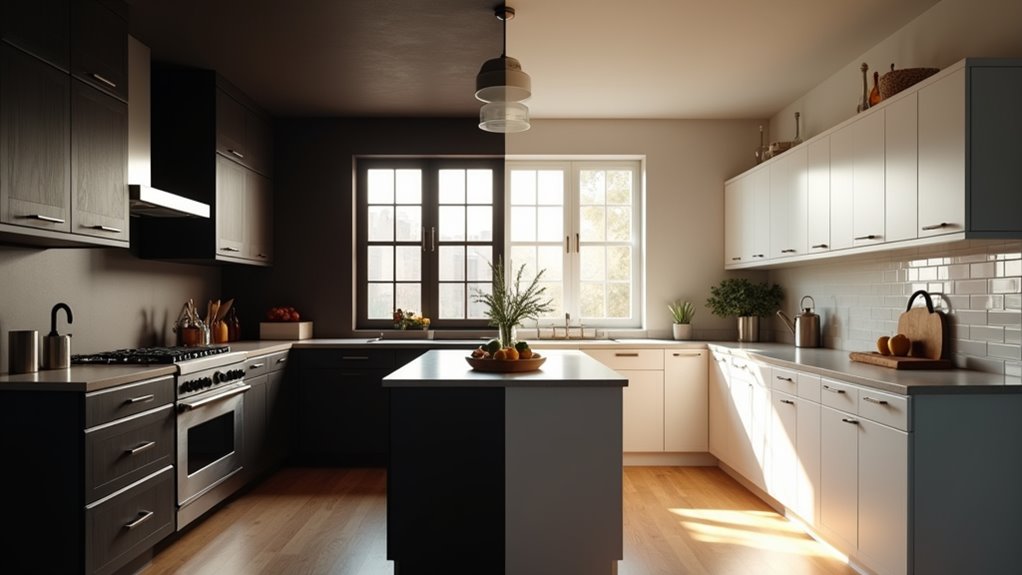
When considering the influence of kitchen cabinetry on mood and ambiance, the choice between dark and light tones significantly shapes the emotional tone of the space.
Light cabinets, often in crisp whites or soft pastels, craft a bright and welcoming feel that clients adore for its ability to uplift and energize a kitchen.
In contrast, dark cabinetry in deep charcoals or rich navies delivers a bold and dramatic vibe, appealing to those seeking a sophisticated, statement-making environment.
Bright and Welcoming Feel
Kitchens with light-colored cabinets effortlessly transform a space into a bright and welcoming haven. They create a bright atmosphere that uplifts the mood, reflecting natural light to energize the area and craft an inviting environment for gatherings.
This design choice suits clients seeking a warm, open aesthetic that enhances well-being.
To envision the impact, consider:
- Sunlit Mornings: White cabinets reflecting dawn’s glow, making the kitchen feel airy and vibrant.
- Social Hub: Cream tones softening the space, drawing family and friends to linger over coffee.
- Spacious Illusion: Light wood grains expanding a compact layout, offering a cozy yet open feel.
Such elements ensure a kitchen remains a cherished, mood-boosting centerpiece for any home.
Bold and Dramatic Vibe
Shifting the focus from airy brightness, dark kitchen cabinets offer a striking contrast with their bold and dramatic vibe, profoundly shaping the mood and ambiance of a space.
Embracing dark aesthetics, these cabinets create a powerful design statement, infusing kitchens with sophistication and depth. Their deep tones, such as black or navy, establish a formal, intimate atmosphere, ideal for clients seeking a luxurious or cozy feel.
When paired with metallic accents or lighter countertops, the dramatic effect intensifies, balancing visual weight. Adequate lighting ensures the space avoids feeling somber, while glossy finishes reflect light for a modern edge.
For trend-savvy homeowners, dark cabinetry transforms kitchens into captivating focal points, aligning with contemporary desires for bold, elegant interiors.
Maintenance and Cleaning Challenges
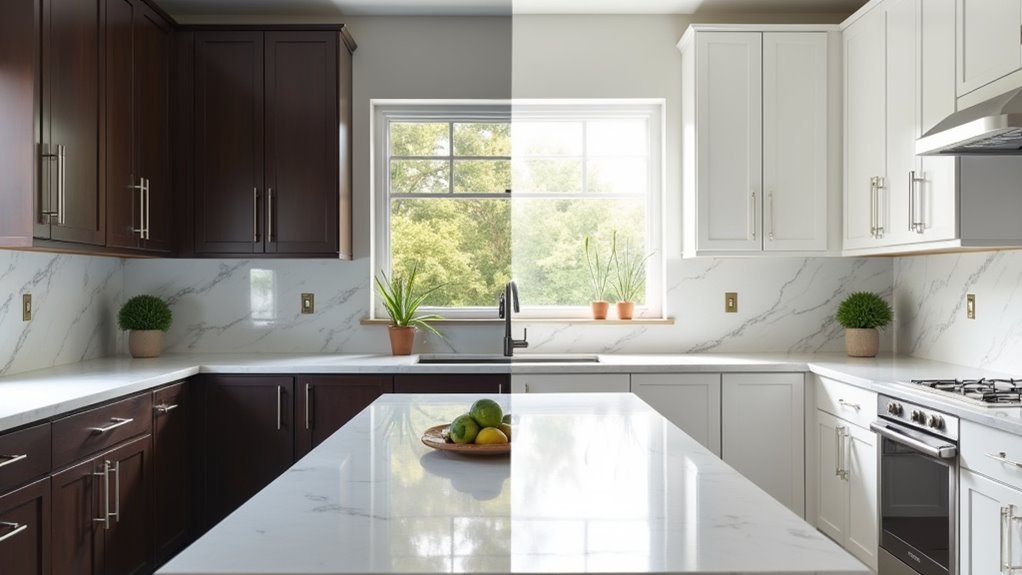
Although kitchen cabinets serve as a focal point of style, their maintenance and cleaning challenges often influence a homeowner’s decision between dark and light finishes.
Dark cabinets, while aligning with bold aesthetic preferences, reveal dust and fingerprints easily, demanding higher cleaning frequency and meticulous maintenance routines. Light cabinets, on the other hand, expose dirt and stains prominently, posing unique surface challenges that require consistent attention.
Dark cabinets highlight dust and fingerprints, requiring frequent cleaning, while light cabinets expose stains, demanding constant care for pristine surfaces.
Consider these vivid scenarios to understand the upkeep:
- Dark Cabinets: Smudges on glossy finishes stand out, necessitating specific cleaning techniques and gentle product recommendations like mild soap to avoid wear visibility.
- Light Cabinets: Spills and grime near stovetops become glaring, urging immediate wiping to sidestep durability concerns.
- Daily Impact: Both demand tailored maintenance routines, with microfiber cloths as a go-to for preventing scratches across finishes.
Ultimately, aligning cleaning efforts with lifestyle ensures cabinets retain their trend-forward appeal for clients.
Durability Over Time
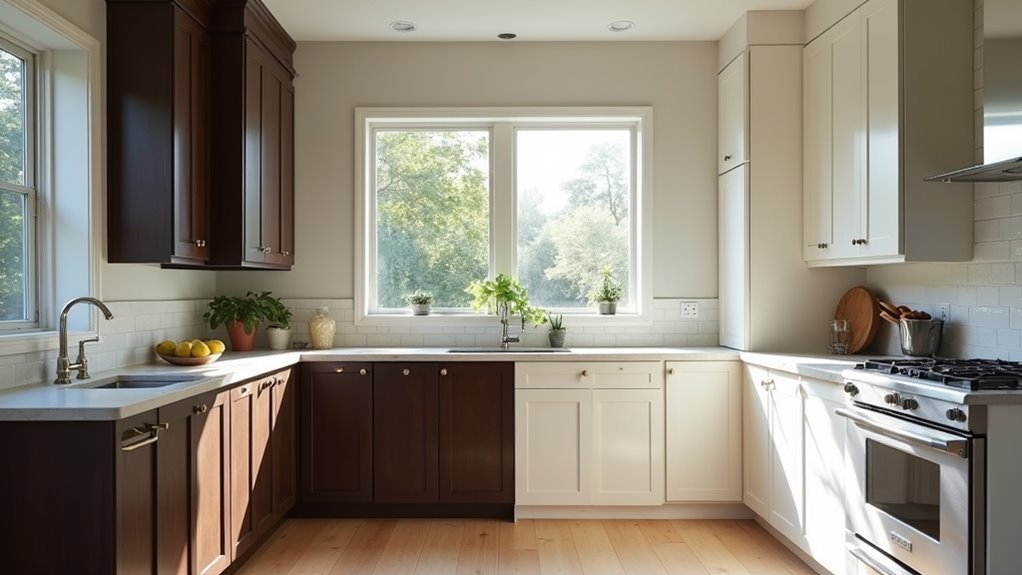
While kitchen cabinets are pivotal in defining a space’s aesthetic, their durability over time remains a critical consideration for homeowners seeking lasting value. Dark cabinets often excel in concealing minor wear visibility, hiding smudges and dents better than light ones, though scratches may stand out if lighter material is exposed beneath.
Light cabinets, particularly white, reveal dirt and spills more readily, impacting maintenance ease.
Both shades face challenges with color fading from sunlight exposure, though modern finishes with UV inhibitors enhance finish durability.
Material longevity plays a significant role—solid wood and laminates offer robust scratch resistance, with laminates resisting impact and moisture across light and dark tones.
Stained finishes on dark cabinets may mask scratches better than painted light ones, ensuring longevity.
For clients prioritizing durability, choosing high-quality materials and finishes is key to sustaining a kitchen’s appeal over years.
Effect on Resale Value
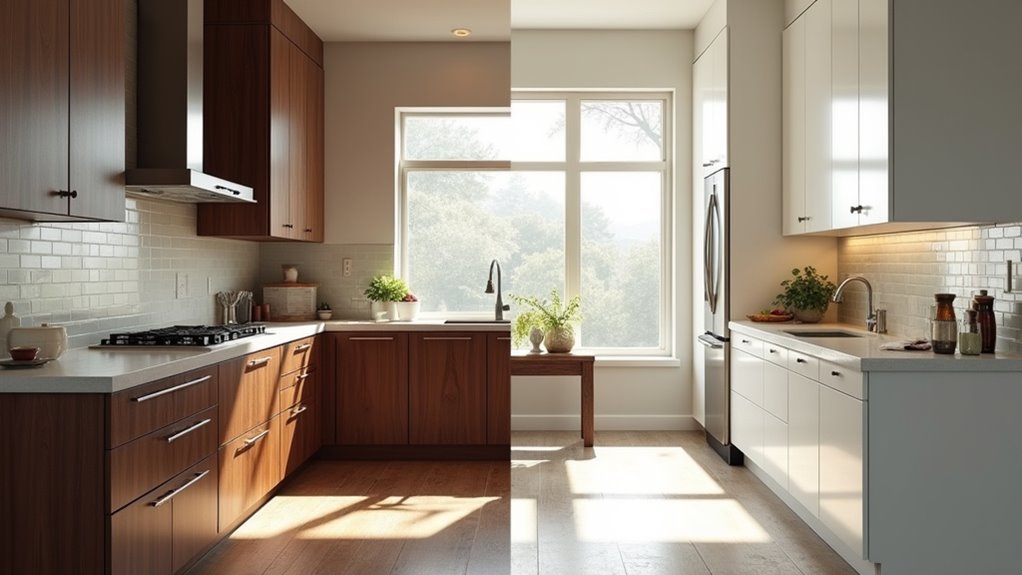
When considering the effect of kitchen cabinet colors on resale value, market appeal trends show a clear preference for light, neutral tones like white and soft gray, which resonate with a wide array of potential buyers.
Buyer preference impact is significant, as these lighter shades create a versatile, airy feel that often translates to quicker sales and higher offers in competitive markets.
Value perception factors further highlight that light cabinets can enhance a home’s perceived worth, while dark tones, though elegant, may limit appeal unless balanced with strategic design elements.
Market Appeal Trends
As homeowners consider kitchen renovations, the choice between dark and light cabinets significantly impacts market appeal and resale value.
Market trends indicate that light cabinets, especially white, hold timeless charm and cater to diverse buyer demographics, often enhancing perceived value. Dark cabinets, meanwhile, appeal to niche markets seeking modern luxury, though they risk limiting interest in smaller spaces.
Current insights reveal key influences on appeal:
- Light Neutrals: White and soft grays create a bright, spacious feel, aligning with broad market preferences.
- Dark Sophistication: Espresso or charcoal tones offer high-end contrast, fitting contemporary trends for selective buyers.
- Natural Tones: Light oak and greige finishes reflect a resurgence, blending warmth with versatility for varied architectural styles.
Buyer Preference Impact
The choice between dark and light kitchen cabinets plays a pivotal role in shaping buyer preferences and influencing resale value.
Light cabinets, particularly white, align with buyer desires for bright, spacious kitchens, often boosting resale value by up to 15% due to their timeless appeal. They attract a broader audience with a neutral canvas that suits diverse style preferences.
Conversely, dark cabinets exude luxury and sophistication, appealing to niche buyer desires in larger, well-lit spaces, but risk deterring others by making smaller kitchens feel cramped. Their bold aesthetic may not match all style preferences, potentially lengthening time on the market.
Ultimately, cabinet color significantly sways first impressions, guiding buyers toward homes that resonate with their vision.
Value Perception Factors
Perspective on kitchen cabinet color significantly shapes resale value through various value perception factors. Color psychology plays a pivotal role, as light cabinets often evoke a sense of spaciousness and cleanliness, enhancing aesthetic appeal for potential buyers.
Dark cabinets, while elegant, may risk appearing dated or confining, impacting buyer interest.
Key influences on resale value include:
- Timelessness: Neutral, light tones like white remain universally appealing, ensuring enduring aesthetic appeal.
- Spatial Perception: Light cabinets reflect light, making kitchens feel larger—a critical factor in buyer decisions.
- Trend Risks: Dark cabinets tied to fleeting trends may deter buyers if styles shift.
Understanding these elements helps clients maximize resale potential by aligning with market preferences and color psychology insights.
Alignment With Design Trends
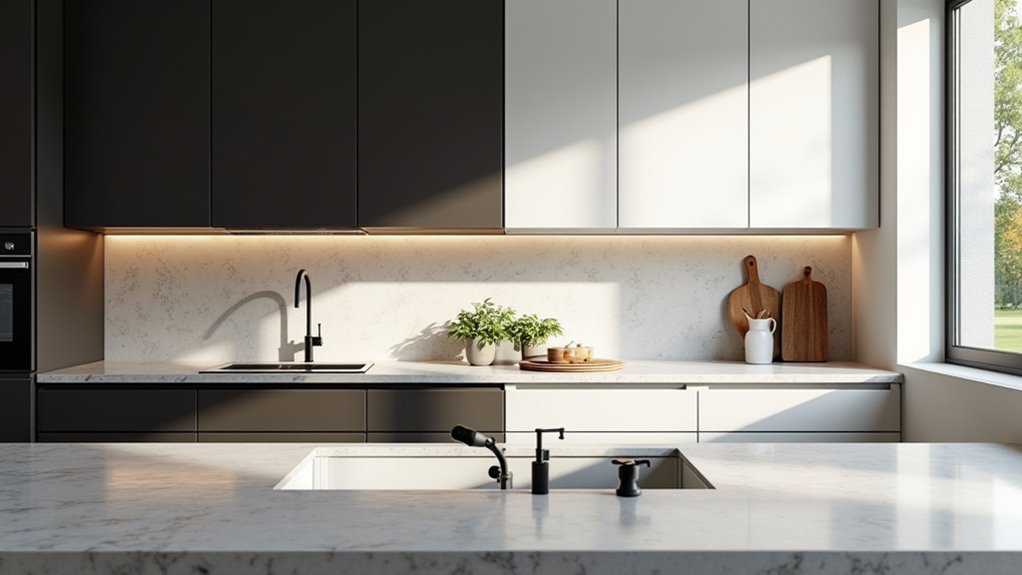
Innovation in kitchen design continually reshapes homeowner preferences, with color palettes and cabinet styles reflecting broader aesthetic movements. Current trends highlight a shift from sterile all-white or gray kitchens to warmer, natural tones like green, terracotta, and soft creams, driven by color psychology and evolving design preferences.
These earthy hues connect spaces to nature, offering clients a cozy, inviting ambiance that resonates with modern sensibilities.
Dark cabinetry, in shades like charcoal and deep navy, is gaining traction for its luxurious, dramatic appeal, often balanced with lighter elements for sophistication. Conversely, light cabinets, such as white oak, maintain timeless charm, aligning with minimalist and Scandinavian influences to brighten and expand spaces.
Two-tone designs, pairing dark lowers with light uppers, cater to personalized tastes, blending warmth and contrast. These trends empower homeowners to create kitchens that reflect both style and contemporary aesthetic values.
Flexibility in Styling Options

While kitchen design trends evolve, flexibility in styling options remains a key consideration for homeowners seeking to personalize their spaces.
Both dark and light kitchen cabinets offer remarkable stylistic versatility, allowing clients to craft a tailored aesthetic with design cohesiveness at the forefront.
Light cabinets provide a neutral canvas, pairing effortlessly with vibrant backsplashes or bold hardware, while dark cabinets deliver dramatic contrast against lighter countertops or reflective fixtures.
Light cabinets offer a versatile backdrop for bold accents, while dark cabinets create striking contrast with lighter elements for a dynamic kitchen design.
To envision the possibilities, consider these styling scenarios:
- Light Cabinets: White cabinets with brushed brass hardware and a dark granite countertop create a warm, inviting contrast.
- Dark Cabinets: Black cabinets paired with a cream marble countertop and satin brass pulls offer a sophisticated, balanced look.
- Two-Tone Design: Light oak uppers with dark gray lowers blend warmth and depth for a modern, cohesive space.
This adaptability ensures homeowners can achieve a personalized, trend-forward kitchen that reflects their unique vision.
Lighting Requirements and Effects
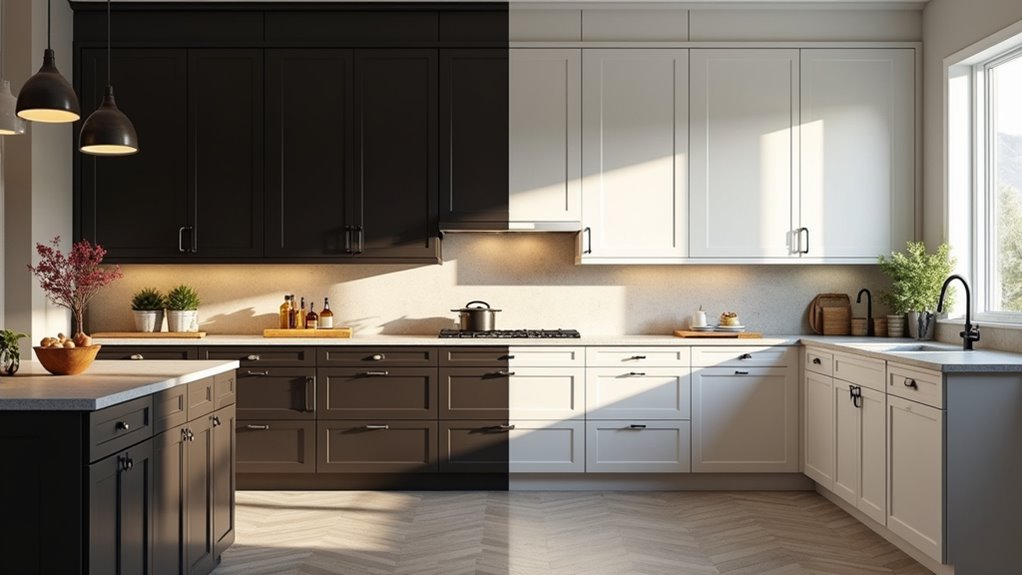
How does lighting transform the ambiance of a kitchen with dark or light cabinets?
Lighting, both natural light and artificial lighting, plays a pivotal role in shaping the mood through ambiance control. Light cabinets create bright reflections, amplifying natural light and reducing the need for extensive fixtures. Meanwhile, dark cabinets exhibit dark absorption, often requiring robust lighting strategies to balance the space.
Strategic use of lighting layers—ambient, task, and accent—ensures functionality and style. Under-cabinet lights aid shadow reduction, especially with dark tones. Reflective finishes on either shade bounce light for added brightness.
Color temperature also matters; warm tones enrich dark cabinets, whereas cool tones enhance light ones for a crisp look. For clients seeking tailored solutions, combining natural light optimization with smart artificial lighting offers flexibility.
Such thoughtful lighting strategies ensure kitchens, regardless of cabinet color, feel inviting and perfectly illuminated for any task.
Perception of Kitchen Size
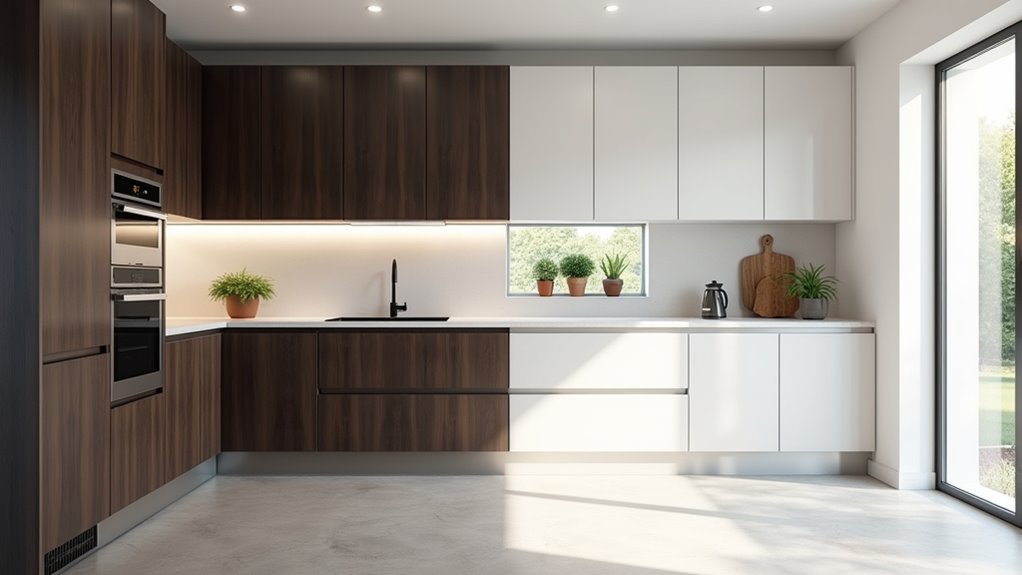
The perception of kitchen size is profoundly influenced by the choice of cabinet color, a critical consideration for clients aiming to optimize their space.
Light cabinets, such as white or soft pastels, enhance perceived spaciousness by reflecting light, creating visual openness that makes even small kitchens feel airy.
Conversely, dark cabinets can absorb light, adding visual weight and potentially shrinking the space, though they bring sophistication to larger areas.
Strategic color contrast, like two-tone designs, can balance these effects for design harmony.
Consider these impactful choices:
- Light Shades for Expansion – Whites and creams reflect light, amplifying visual openness in compact kitchens.
- Dark Tones for Depth – In spacious layouts, dark cabinets add coziness without overwhelming.
- Two-Tone Dynamics – Pairing light upper cabinets with darker bases maintains perceived spaciousness while grounding the room.
Clients can thus tailor cabinet colors to transform spatial perceptions effectively.
Balance With Other Design Elements
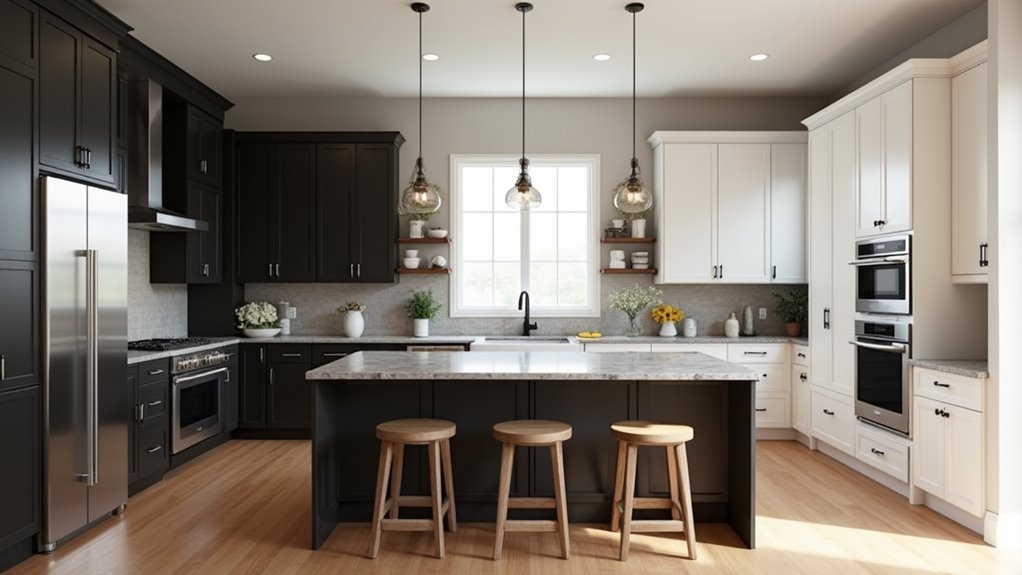
When designing a kitchen with dark or light cabinets, achieving harmony with countertop colors is crucial for a cohesive aesthetic, whether opting for striking contrasts or subtle tonal matches that align with current trends.
Equally important is selecting a backsplash that offers contrast or complements the cabinetry, using materials like glass tiles or patterned designs to elevate visual interest for clients seeking a personalized touch.
Additionally, balancing flooring tones—whether light hardwoods with dark cabinets or rich stains with light ones—grounds the space and ensures a polished, client-focused design.
Countertop Color Harmony
As kitchen design evolves, achieving countertop color harmony remains a pivotal aspect of balancing aesthetics with functionality. For clients seeking a cohesive look, countertop material choices and countertop texture variations play a crucial role in complementing dark or light cabinets.
The right selection can elevate the kitchen’s style while ensuring balance with flooring and walls.
Consider these harmonious pairings:
- Light Countertops with Dark Cabinets – White or veined marble reflects light, softening the intensity of espresso tones.
- Dark Countertops with Light Cabinets – Black granite offers bold contrast, ideal for modern minimalist spaces.
- Neutral Tones for Versatility – Gray or beige quartz blends seamlessly, maintaining elegance across diverse palettes.
Such choices ensure a tailored, trend-forward kitchen design for every client.
Backsplash Contrast Ideas
Designers often find that backsplash choices can dramatically shape a kitchen’s aesthetic, building on the foundation of countertop harmony with dark or light cabinets. The right backsplash materials, color selection, and texture options can enhance depth perception, influenced by lighting. Glossy finish types reflect light, while metallic accents align with style trends for modern elegance.
Pattern choices like geometric or subway tiles, paired with precise installation techniques, create visual interest. Maintenance considerations are key—natural stone offers luxury but requires care. Below, explore curated ideas:
| Backsplash Style | Best Paired With |
|---|---|
| Glossy Zellige Tiles | Dark Cabinets for Depth |
| Metallic Copper | Dark Cabinets for Glamour |
| Marble Mosaic | Light Cabinets for Luxury |
| Glass Subway Tiles | Dark Cabinets for Lightness |
Flooring Tone Balance
While kitchen cabinets often steal the spotlight, flooring plays an equally critical role in establishing a balanced and visually appealing space. Achieving harmony involves careful attention to color temperature and undertone matching, ensuring a seamless flow between elements.
Texture pairing and style coherence also elevate the design, aligning flooring with cabinets, countertops, and the kitchen’s overall aesthetic.
Consider these impactful combinations for inspiration:
- Dark cabinets with light oak flooring – A warm color temperature contrast that brightens the space.
- Light gray cabinets with slate floors – Cool undertone matching for a modern, cohesive look.
- Matte white cabinets with polished wood flooring – Texture pairing that adds depth and sophistication.
Such choices ensure a tailored, trend-forward kitchen for discerning clients.
